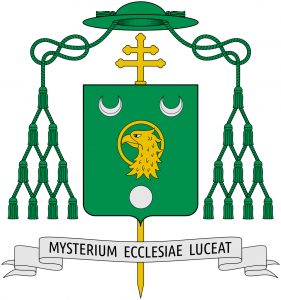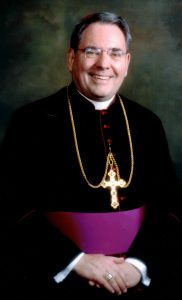Archbishop John J. Myers, former bishop of Peoria, Newark archbishop emeritus, dies

Bishop John J. Myers visits with St. John Paul II during an ad limina visit to the Vatican representing the Diocese of Peoria in 1997. Archbishop Myers, archbishop emeritus of Newark, died Sept. 24, 2020, in Ottawa, Illinois. (Photo by Felici)
(UPDATED ON SEPT. 25)
OTTAWA — Archbishop John J. Myers, the seventh Bishop of Peoria who went on to lead the Archdiocese of Newark from 2001 until his retirement in 2016, died early Thursday morning, Sept. 24, 2020, at a senior care facility here. He was 79.
A native of Earlville, Archbishop Myers was a priest of the Diocese of Peoria who would guide the diocese into the third millennium of Christianity, first as coadjutor bishop assisting Bishop Edward W. O’Rourke from 1987 to 1990, and then as the diocese’s chief shepherd for the next 11 years.
At the request of Archbishop Myers’ family, the visitation and funeral Mass will take place at St. Mary’s Cathedral in Peoria. Visitation is scheduled from 3 p.m. to 8 p.m. on Tuesday, Sept. 29, with recitation of the rosary at 7 p.m. Participants will be expected to wear a face covering and to observe social distancing.
The funeral Mass will be celebrated at 11 a.m. on Wednesday, Sept. 30. Because of limitations on seating brought on by the pandemic, the funeral Mass will not be open to the public, with admission limited to family members, visiting cardinals and bishops, and priests of the Diocese of Peoria and the Archdiocese of Newark. An additional hour of visitation will precede the funeral Mass.
The funeral Mass will be livestreamed on the Diocese of Peoria’s home page, cdop.org.
Burial will be in the Bishops’ Mausoleum at St. Mary’s Cemetery in West Peoria.
Bishop Daniel R. Jenky, CSC, announced the death of his predecessor “with deep sadness and yet with confidence in the power of Christ’s resurrection.”
Upon hearing the news of Archbishop Myers’ passing, Cardinal Joseph W. Tobin, C.Ss.R., his successor as Archbishop of Newark, said, “On behalf of my brother Bishops and the entire family of God here in our local Church of Newark, I extend my heartfelt prayers and condolences to his family. Let us thank God for Archbishop Myers’ service and his love of our Church. I entrust him to the loving arms of our Blessed Mother Mary, and I pray that Our Lord grant him peace.”
A Memorial Mass for Archbishop Myers will be celebrated in the Cathedral Basilica of the Sacred Heart in Newark at a future date.
STRONG LEADERSHIP, CLEAR TEACHING
Only the second native son of the diocese to serve as its chief shepherd, Archbishop Myers’ years as diocesan bishop in Peoria were characterized by increases in vocations to the priesthood and Eucharistic devotion, as well as by a strong leadership style emphasizing “crisp and clear Catholic identity” and fidelity to church teaching. He presided over several major events preparing for the arrival of the Year 2000, including a series of regional Masses attracting thousands.
Some of the more than 80 priests he ordained began their seminary studies while then-Father Myers was diocesan vocations director in the 1980s.
Pope John Paul II named him Archbishop of Newark, the seventh-largest archdiocese in the U.S., on July 24, 2001. Upon his installation in New Jersey less than two months later, Archbishop Myers inherited an archdiocese that was reeling from the events of Sept. 11 in neighboring New York City. Just two days after his installation, Archbishop Myers released a pastoral letter seeking to assuage the pain and suffering of families who had lost loved ones, provide spiritual guidance and counsel, and reinforce the Church’s teaching on God’s divine mercy. It was titled “If God is For Us, Who Can Be Against Us? Reflections on Faith and Terrorism.”
EARLVILLE NATIVE, EARLY PRIESTHOOD
Born July 26, 1941, in Ottawa, Illinois, Archbishop Myers was the oldest of seven children of Jack and Margaret Myers. The Myers family farmed near Earlville, and the children all worked with their father and shared the family chores. Young John Myers was an altar server in his parish, St. Theresa, from an early age.
He attended Loras College in Dubuque, Iowa, originally intending to be a lawyer. It was during a retreat in his freshman year that he began to seriously consider the priesthood.
After earning a political science degree from Loras, he was sent by Peoria Bishop John B. Franz to study theology at the North American College, Gregorian University in Rome, from which he received his licentiate in 1967. He would later obtain a canon law degree from the Catholic University of America.
He was ordained a priest by Bishop Francis Reh at the Altar of the Chair in St. Peter’s Basilica on Dec. 17, 1966. Within the Diocese of Peoria, he served as assistant at Holy Family Parish, Peoria, and St. Matthew Parish in Champaign.

The coat of arms of Archbishop Myers. His motto translates as “Let the Mystery of the Church Shine Forth.”
In 1977, he began a series of administrative posts including a decade as vocations director and chancellor. He was vicar general from 1983 to 1990.
Upon his ordination as coadjutor bishop on Sept. 3, 1987, at St. Mary’s Cathedral, he chose the episcopal motto “Mysterium Ecclesiae Luceat,” or “Let the Mystery of the Church Shine Forth.”
SEVENTH BISHOP OF PEORIA
The first of the seven pastoral letters he penned as Bishop of Peoria – “The Obligations of Catholics and the Rights of Unborn Children” — thrust him into the national spotlight. It contained teaching targeted to both voters and Catholic politicians, as well as forceful declarations such as “There is, and can be, no such thing as an authentic ‘pro-choice’ Catholic.”
His next pastoral letter, “The Eucharist: Sacrifice of Love,” also released during his first year as Ordinary, began an 18-month planning process for the Diocese of Peoria’s first Eucharistic Congress. That celebration attracted 6,500 people to the Peoria Civic Center on June 21, 1992.
Other highlights of his leadership in the Diocese of Peoria included:
- the dedication in September 2000 of The High School of Saint Thomas More in Champaign, the first newly established Catholic secondary school for the diocese in 35 years;
- the welcoming of several religious orders into the diocese, including the Community of St. John, which established worldwide English-language novitiates for priests, brothers, and sisters just outside of Peoria. Others included the sisters of St. Francis of the Martyr St. George, the Poor Clares, and the Missionaries of Charity, which opened a convent next to St. Mary’s Cathedral in Peoria and welcomed a visit from (now saint) Mother Teresa of Calcutta in 1995, and
- the establishment of the St. John Bosco Catechetical Institute to train, certify, update and recruit “a veritable army of teachers and catechists” to effect a period of catechetical renewal in the diocese.
He established awards to recognize those who have made outstanding contributions to the faith both locally and nationally. They include the Pere Marquette Medal for local service and the John Lancaster Spalding Medal, named for the Diocese of Peoria’s founding bishop, for service to the church on a national scale.
FIFTH ARCHBISHOP OF NEWARK
On July 24, 2001, Pope John Paul II appointed Bishop Myers as the fifth Archbishop of Newark. He was installed on Oct. 9, 2001, and officiated at numerous funerals and services for those who perished in the World Trade Center attacks. The pope conferred the Pallium on Archbishop Myers on June 29, 2002.
Archbishop Myers oversaw the celebration of the Archdiocese of Newark’s 150th Anniversary in 2003. During his years in Newark, he launched studies and initiatives to help parishes and Catholic schools strengthen their presence in northern New Jersey. He helped raise awareness both in New Jersey and nationally to the sin of human trafficking.
Archbishop Myers served as president of the board of regents and chair of the board of trustees of Seton Hall University, the archdiocesan university.
Archbishop Myers was active in national and international church affairs. He was an early and avid supporter of the Pope John Paul II Cultural Center in Washington, D.C. He also served on the Board of Governors of the National Catholic Bioethics Center in Boston; the Seminary Committee and Board of Trustees of Catholic University of America; the Papal Foundation; the Shrine of the Immaculate Conception; the U.S. Conference of Catholic Bishops Committee on Hispanic Affairs and the Committee for Aid to the Church in Eastern Europe and the former Soviet Union.
Upon reaching the mandatory retirement age of 75, Archbishop Myers submitted his letter of resignation as Archbishop of Newark. His resignation was accepted on Nov. 7, 2016, and he was granted the title Archbishop Emeritus of Newark.
Archbishop Myers was preceded in death by his parents and is survived by his six siblings, Larry (Phyllis) Myers of Ottawa, Bill (Martha) Myers of Earlville, Mary Margaret (Joe) Didier of Sugar Grove, Elizabeth Myers of Peoria, Loretta Malley of Yorkville, and Don (Cindy) Myers of Bloomington; and numerous nieces and nephews and great-nieces and nephews.
—
EDITOR’S NOTE: The Oct. 11 edition of The Catholic Post will be a special issue with extended coverage of the funeral Mass for Archbishop Myers and a review of his lifelong service to the church and impact on the Diocese of Peoria.






